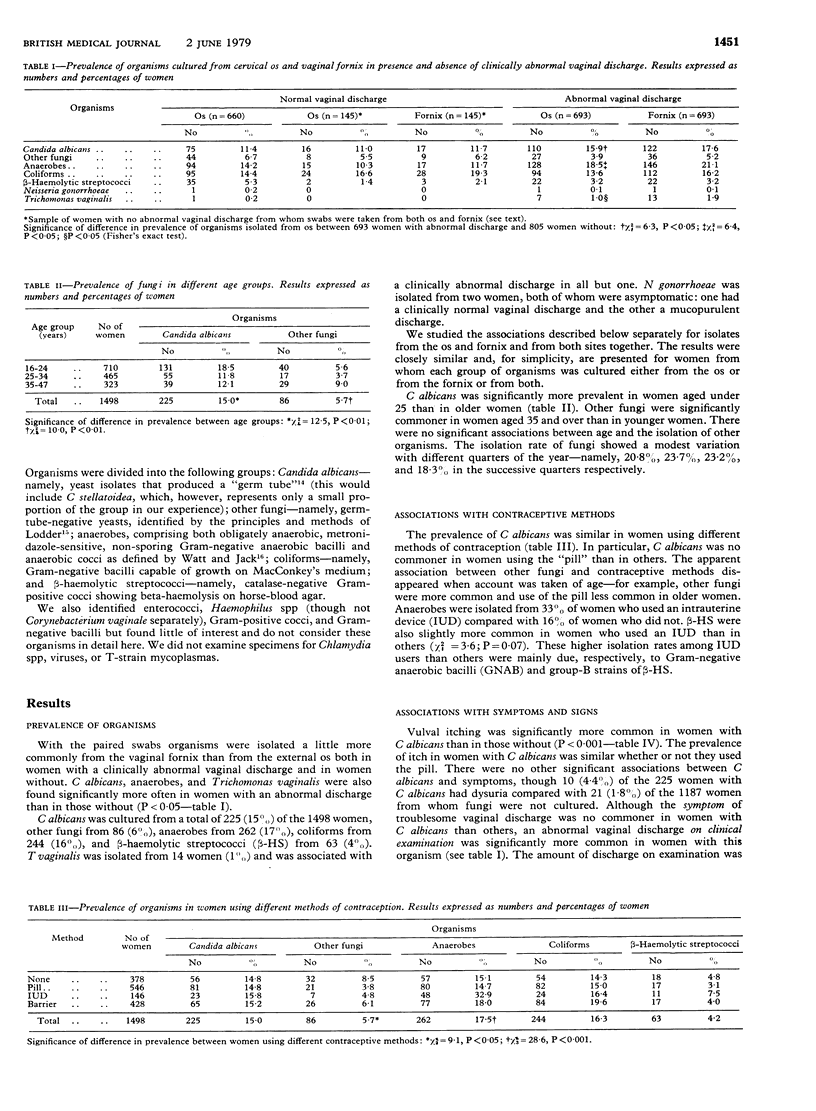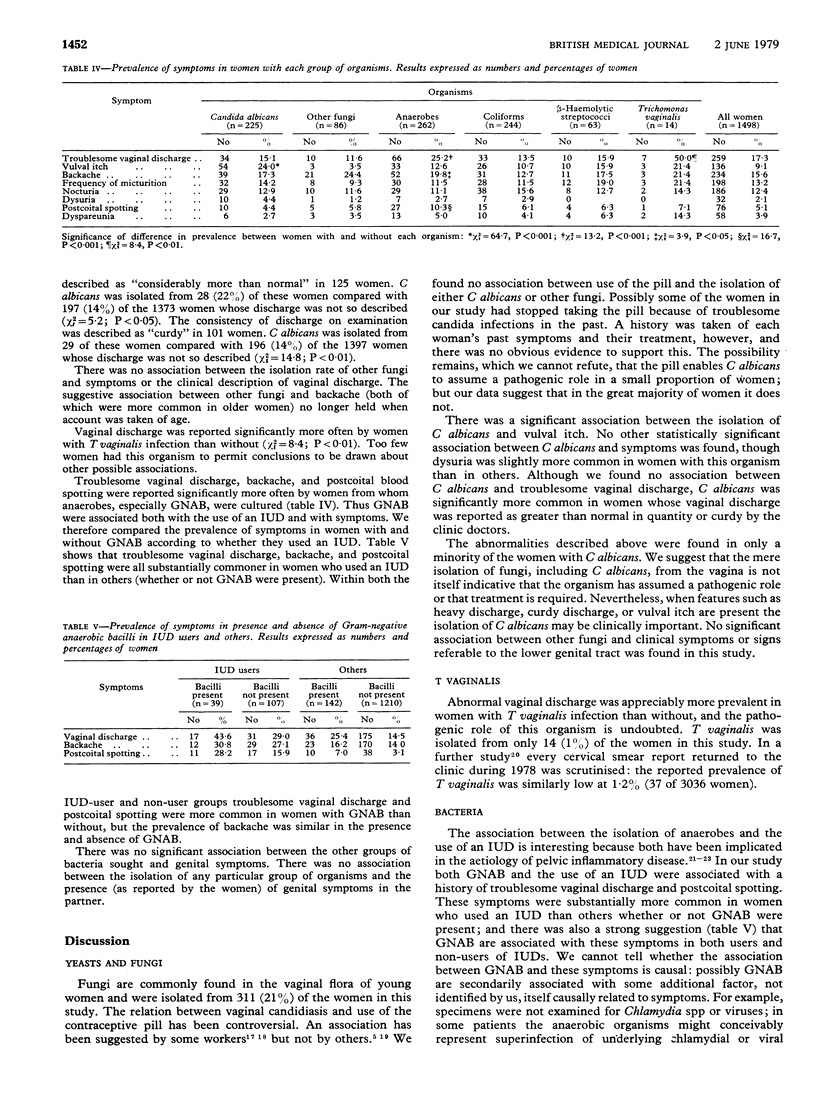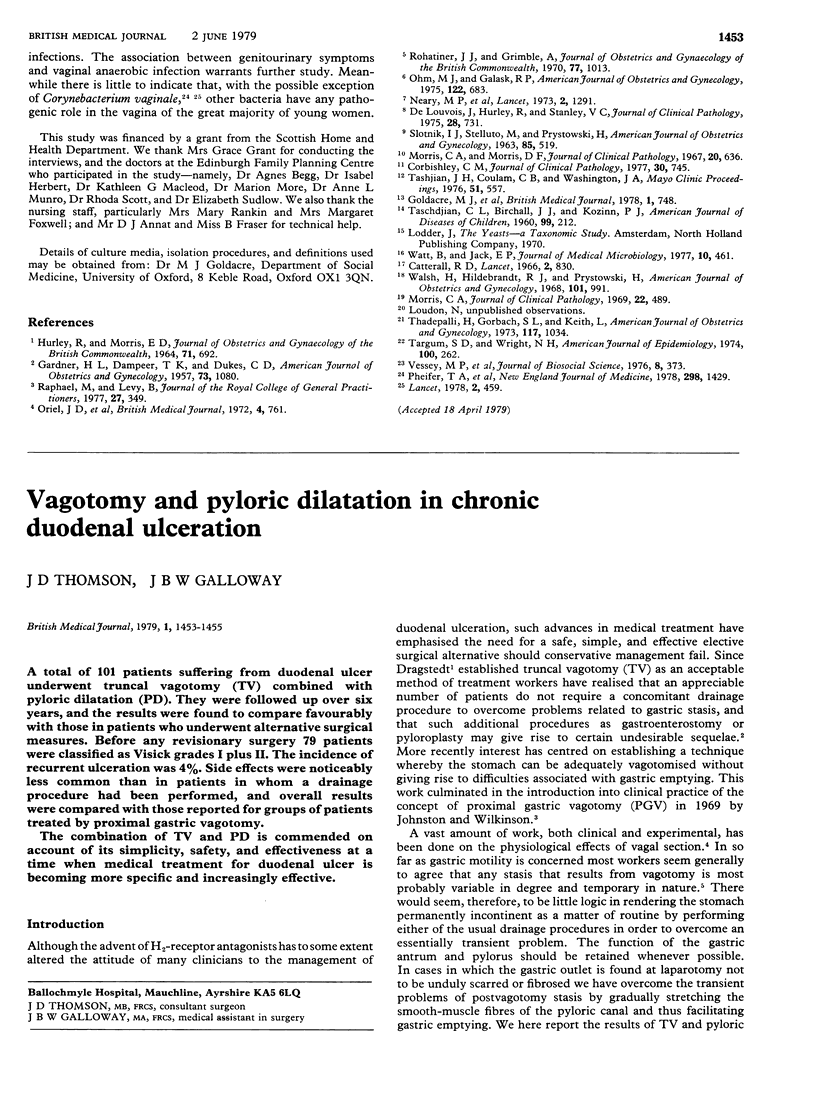Abstract
Vaginal swabs were taken from 1498 women attending a family planning clinic. The flora was assessed in the absence of any information about the women to whom the swabs related. Yeasts and fungi were present in 311 women (21%) and were no more prevalent among "pill" users than others. Candida albicans was significantly associated with vulval itching and with a vaginal discharge described as heavier than normal or curdy on clinical examination, though these abnormalities were present in only a minority of women with the organism. Trichomonas vaginalis was found in 14 women (1%) and was associated with abnormalities of vaginal discharge in all but one. Gram-negative anaerobic bacilli were significantly more common in women with a troublesome vaginal discharge and those who used an intrauterine device than others. No associations were found between fungi other than C albicans or the other bacteria sought and either symptoms or clinical abnormalities of vaginal discharge.
Full text
PDF



Selected References
These references are in PubMed. This may not be the complete list of references from this article.
- Catterall R. D. Candida albicans and the contraceptive pill. Lancet. 1966 Oct 15;2(7468):830–831. doi: 10.1016/s0140-6736(66)92256-2. [DOI] [PubMed] [Google Scholar]
- Corbishley C. M. Microbial flora of the vagina and cervix. J Clin Pathol. 1977 Aug;30(8):745–748. doi: 10.1136/jcp.30.8.745. [DOI] [PMC free article] [PubMed] [Google Scholar]
- GARDNER H. L., DAMPEER T. K., DUKES C. D. The prevalence of vaginitis; a study in incidence. Am J Obstet Gynecol. 1957 May;73(5):1080-5; discussion, 1085-7. doi: 10.1016/s0002-9378(16)37178-2. [DOI] [PubMed] [Google Scholar]
- HURLEY R., MORRIS E. D. THE PATHOGENICITY OF CANDIDA SPECIES IN THE HUMAN VAGINA. J Obstet Gynaecol Br Commonw. 1964 Oct;71:692–695. doi: 10.1111/j.1471-0528.1964.tb04341.x. [DOI] [PubMed] [Google Scholar]
- Morris C. A., Morris D. F. Normal vaginal microbiology of women of childbearing age in relation to the use of oral contraceptives and vaginal tampons. J Clin Pathol. 1967 Jul;20(4):636–640. doi: 10.1136/jcp.20.4.636. [DOI] [PMC free article] [PubMed] [Google Scholar]
- Neary M. P., Allen J., Okubadejo O. A., Payne D. J. Preoperative vaginal bacteria and postoperative infections in gynaecological patients. Lancet. 1973 Dec 8;2(7841):1291–1294. doi: 10.1016/s0140-6736(73)92870-5. [DOI] [PubMed] [Google Scholar]
- Ohm M. J., Galask R. P. Bacterial flora of the cervix from 100 prehysterectomy patients. Am J Obstet Gynecol. 1975 Jul 15;122(6):683–687. doi: 10.1016/0002-9378(75)90571-2. [DOI] [PubMed] [Google Scholar]
- Pheifer T. A., Forsyth P. S., Durfee M. A., Pollock H. M., Holmes K. K. Nonspecific vaginitis: role of Haemophilus vaginalis and treatment with metronidazole. N Engl J Med. 1978 Jun 29;298(26):1429–1434. doi: 10.1056/NEJM197806292982601. [DOI] [PubMed] [Google Scholar]
- Raphael M., Levy B. The value of vaginal cultures in general practice. J R Coll Gen Pract. 1977 Jun;27(179):349–351. [PMC free article] [PubMed] [Google Scholar]
- Rohatiner J. J., Grimble A. Genital candidasis and oral contraceptives. J Obstet Gynaecol Br Commonw. 1970 Nov;77(11):1013–1015. doi: 10.1111/j.1471-0528.1970.tb03448.x. [DOI] [PubMed] [Google Scholar]
- Targum S. D., Wright N. H. Association of the intrauterine device and pelvic inflammatory disease: a retrospective pilot study. Am J Epidemiol. 1974 Oct;100(4):262–271. doi: 10.1093/oxfordjournals.aje.a112034. [DOI] [PubMed] [Google Scholar]
- Tashjian J. H., Coulam C. B., Washington J. A., 2nd Vaginal flora in asymptomatic women. Mayo Clin Proc. 1976 Sep;51(9):557–561. [PubMed] [Google Scholar]
- Thadepalli H., Gorbach S. L., Keith L. Anaerobic infections of the female genital tract: bacteriologic and therapeutic aspects. Am J Obstet Gynecol. 1973 Dec 15;117(8):1034–1040. doi: 10.1016/0002-9378(73)90750-3. [DOI] [PubMed] [Google Scholar]
- Walsh H., Hildebrandt R. J., Prystowsky H. Oral progestational agents as a cause of Candida vaginitis. Am J Obstet Gynecol. 1968 Aug 1;101(7):991–993. doi: 10.1016/0002-9378(68)90286-x. [DOI] [PubMed] [Google Scholar]
- Watt B., Jack E. P. What are anaerobic cocci? J Med Microbiol. 1977 Nov;10(4):461–468. doi: 10.1099/00222615-10-4-461. [DOI] [PubMed] [Google Scholar]
- de Louvois J., Hurley R., Stanley V. C. Microbial flora of the lower genital tract during pregnancy: relationship to morbidity. J Clin Pathol. 1975 Sep;28(9):731–735. doi: 10.1136/jcp.28.9.731. [DOI] [PMC free article] [PubMed] [Google Scholar]


